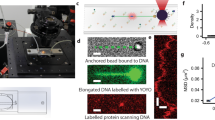Abstract
Biological microelectromechanical systems (bioMEMS) provide an attractive approach to understanding and modifying enzymatic pathways by separating and interrogating individual reaction steps at localized sites in a microfluidic network. We have previously shown that electrodeposited chitosan enables immobilization of an enzyme at a specific site while maintaining its catalytic activity. While promising as a methodology to replicate metabolic pathways and search for inhibitors as drug candidates, these investigations also revealed unintended (or parasitic) effects, including products generated by the enzyme either (1) in the homogeneous phase (in the liquid), or (2) nonspecifically bound to microchannel surfaces. Here we report on bioMEMS designs which significantly suppress these parasitic effects. To reduce homogeneous reactions we have developed a new packaging and assembly strategy which eliminates fluid reservoirs that are commonly used for fluidic interconnects with external tubing. To suppress reactions by nonspecifically bound enzyme on microchannel walls we have implemented a cross-flow microfluidic network design so that enzyme flow for assembly and substrate/product for reaction share only the region where the enzyme is immobilized at the intended reaction site. Our results show that the signal-to-background ratio of sequential enzymatic reactions increases from 0.72 to 1.28 by eliminating the packaging reservoirs, and increases to 2.43 by separating the flow direction of enzymatic reaction from that of enzyme assembly step. These techniques can be easily applied to versatile microfluidic devices to minimize parasitic reactions in sequential biochemical reactions.







Similar content being viewed by others
References
A.A.S. Bhagat, P. Jothimuthu, A. Pais, I. Papautsky, J. Micromech. Microeng 17, 42–49 (2007) doi:10.1088/0960-1317/17/1/006
U. Bilitewski, M. Genrich, S. Kadow, G. Mersal, Anal. Bioanal. Chem 377, 556–569 (2003) doi:10.1007/s00216-003-2179-4
A.M. Christensen, D.A. Chang-Yen, B.K. Gale, J. Micromech. Microeng 15, 928–934 (2005) doi:10.1088/0960-1317/15/5/005
J.A. Duerre, J Biol Chem 237, 3737–3741 (1962)
R. Fernandes, H.M. Yi, L.Q. Wu, G.W. Rubloff, R. Ghodssi, W.E. Bentley et al., Langmuir 20, 906–913 (2004) doi:10.1021/la0357312
A.J. Ferro, A. Barrett, S.K. Shapiro, Biochim. Biophys. Acta 438, 487–494 (1976)
C.K. Fredrickson, Z.H. Fan, Lab Chip 4, 526–533 (2004) doi:10.1039/b410720a
B.L. Gray, S.D. Collins, R.L. Smith, Sens. Actuators A Phys 112, 18–24 (2004) doi:10.1016/j.sna.2003.10.073
A. Han, M. Graff, O. Wang, A.B. Frazier, IEEE Sens. J 5, 82–89 (2005) doi:10.1109/JSEN.2004.838666
D. Janasek, J. Franzke, A. Manz, Nature 442, 374–380 (2006) doi:10.1038/nature05059
S. Kim, B. Huang, R.N. Zare, Lab Chip 7, 1663–1665 (2007) doi:10.1039/b713103h
B.S. Ku, J.H. Cha, A. Srinivasan, S.J. Kwon, J.C. Jeong, D.H. Sherman, Biotechnol. Prog 22, 1102–1107 (2006) doi:10.1021/bp050413+
S.W. Lee, S.S. Lee, Microsyst. Technol.—Micro- and Nanosystems-Information Storage Process. Syst. 14, 205–208 (2008)
A.T. Lewandowski, D.A. Small, T.H. Chen, G.F. Payne, W.E. Bentley, Biotechnol. Bioeng 93, 1207–1215 (2006) doi:10.1002/bit.20840
Z. Long, Z. Shen, D. Wu, J. Qin, B. Lin, Lab Chip 7, 1819–1824 (2007) doi:10.1039/b711741h
X. Luo, A.T. Lewandowski, H. Yi, G.F. Payne, R. Ghodssi, W.E. Bentley, Lab Chip 8, 420–430 (2008) doi:10.1039/b713756g
J.C. McDonald, G.M. Whitesides, Acc. Chem. Res 35, 491–499 (2002) doi:10.1021/ar010110q
J.J. Park, X.L. Luo, H.M. Yi, T.M. Valentine, G.F. Payne, W.E. Bentley, Lab Chip 6, 1315–1321 (2006) doi:10.1039/b603101c
S.R. Quake, A. Scherer, Science 290, 1536–1540 (2000) doi:10.1126/science.290.5496.1536
E.D. Ragione, M. Porcelli, M. Cartenifarina, V. Zappia, Biochem. J 232, 335–341 (1985)
Y.C. Tan, V. Cristini, A.P. Lee, Sens. Actuators B Chem 114, 350–356 (2006) doi:10.1016/j.snb.2005.06.008
T. Thorsen, S.J. Maerkl, S.R. Quake, Science 298, 580–584 (2002) doi:10.1126/science.1076996
P.L. Urban, D.M. Goodall, N.C. Bruce, Biotechnol. Adv 24, 42–57 (2006) doi:10.1016/j.biotechadv.2005.06.001
L.Q. Wu, H.M. Yi, S. Li, G.W. Rubloff, W.E. Bentley, R. Ghodssi, Langmuir 19, 519–524 (2003) doi:10.1021/la026518t
H.M. Yi, L.Q. Wu, W.E. Bentley, R. Ghodssi, G.W. Rubloff, J.N. Culver, Biomacromolecules 6, 2881–2894 (2005) doi:10.1021/bm050410l
Acknowledgements
This work was supported in part by the Robert W. Deutsch Foundation, the National Science Foundation Emerging Frontiers in Research and Innovation (NSF-EFRI) program under NSF-SC03524414, the Maryland NanoCenter and its FabLab facility.
Author information
Authors and Affiliations
Corresponding author
Electronic supplementary material
Below is the link to the electronic supplementary material
ESM 1
DOC (44.5 kb)
Rights and permissions
About this article
Cite this article
Luo, X., Larios Berlin, D., Buckhout-White, S. et al. Design optimization for bioMEMS studies of enzyme-controlled metabolic pathways. Biomed Microdevices 10, 899–908 (2008). https://doi.org/10.1007/s10544-008-9204-5
Published:
Issue Date:
DOI: https://doi.org/10.1007/s10544-008-9204-5




